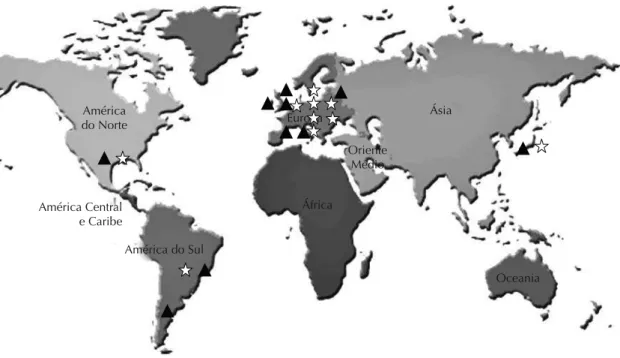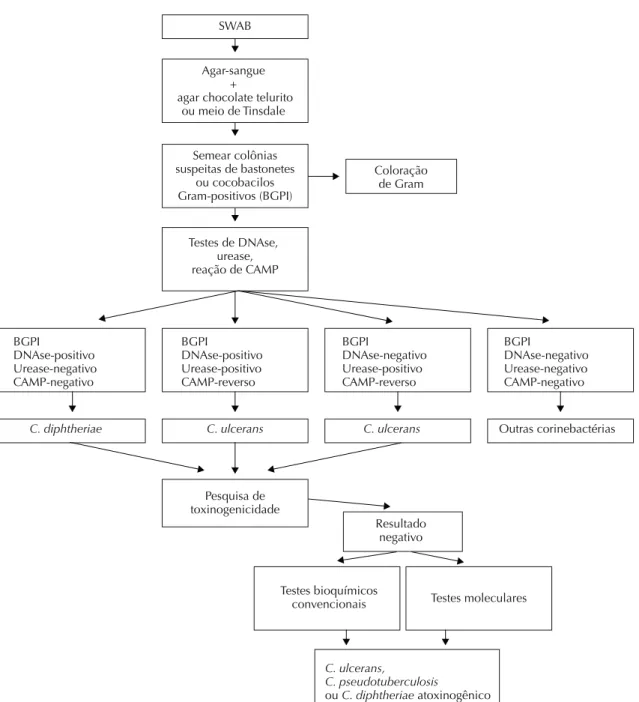Rev Saúde Pública 2012;46(1):203-4
Rev Saúde Pública.
2009; 43(2):214
América do Norte
América Central e Caribe
América do Sul
África
Oriente Médio
Ásia
Oceania Europa
Figura 1. Distribuição mundial de casos notifi cados de infecções pelo Corynebacterium ulcerans em humanos (estrelas) e em animais (triângulos), 1972 a 2010.
No segundo parágrafo de Resultados, onde se lê: “A disponibilidade média de polifenóis ofertada foi de 48,3mg/ dia para o Brasil, sendo a região Sul a que apresentou maior valor (53,6 mg), seguida pelo Sudeste (53,3 mg), Nordeste (45,0 mg), Norte (39,3 mg) e Centro-Oeste (28,2 mg).”, leia-se: “A disponibilidade média de polifenóis ofertada foi de 48,3mg/ dia para o Brasil, sendo a região Sudeste a que apresentou maior valor (53,6 mg), seguida pela Sul (53,3 mg), Nordeste (45,0 mg), Norte (39,3 mg) e Centro-Oeste (28,2 mg).”
In the second paragraph in Results, where it reads: “A disponibilidade média de polifenóis ofertada foi de 48,3mg/ dia para o Brasil, sendo a região Sul a que apresentou maior valor (53,6 mg), seguida pelo Sudeste (53,3 mg), Nordeste (45,0 mg), Norte (39,3 mg) e Centro-Oeste (28,2 mg).”, it should read: “A disponibilidade média de polifenóis ofertada foi de 48,3mg/ dia para o Brasil, sendo a região Sudeste a que apresentou maior valor (53,6 mg), seguida pela Sul (53,3 mg), Nordeste (45,0 mg), Norte (39,3 mg) e Centro-Oeste (28,2 mg).”
Rev Saúde Pública.
2011; 45(6):1181
Figura 1: substituir pelo mapa abaixo.
Figure 1: replace by the map below.
204 Corrigenda
Rev Saúde Pública.
2011; 45(6):1185
Figura 3. Esquema para triagem de Corynebacterium ulcerans. SWAB
Agar-sangue +
agar chocolate telurito ou meio de Tinsdale
Semear colônias suspeitas de bastonetes
ou cocobacilos Gram-positivos (BGPI)
Testes de DNAse, urease, reação de CAMP
BGPI
DNAse-positivo Urease-negativo CAMP-negativo
C. ulcerans,
C. pseudotuberculosis
ou C. diphtheriae atoxinogênico C. diphtheriae C. ulcerans
Pesquisa de toxinogenicidade
Resultado negativo
Testes bioquímicos
convencionais Testes moleculares
C. ulcerans Outras corinebactérias BGPI
DNAse-positivo Urease-positivo CAMP-reverso
BGPI
DNAse-negativo Urease-positivo CAMP-reverso
BGPI
DNAse-negativo Urease-negativo CAMP-negativo Coloração
de Gram Figura 3: substituir pelo diagrama abaixo.

